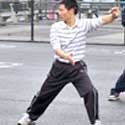One night last week I rode the Staten Island Ferry with a group of friends, celebrating our two friends who were getting hitched at City Hall the next day. The ferry ride is a quintessential New York experience, and one of my favorite things to do in the city. What’s more beautiful than the sight of Manhattan, Brooklyn, and okay, even Jersey City twinkling in the distance?
As the ferry approached the Statue of Liberty, we noticed that just about all of us were immigrants ourselves or had a parent who was born elsewhere; we were from Taiwan, Canada, Argentina, Peru (and New York, California, Kansas, West Virginia). A few taps on someone’s iPhone brought up the poem engraved on the statue’s pedestal. The poem’s called “The New Colossus,” by Emma Lazarus, and here are the famous lines:
“Keep, ancient lands, your storied pomp!” cries she
With silent lips. “Give me your tired, your poor,
Your huddled masses yearning to breathe free,
The wretched refuse of your teeming shore.
Send these, the homeless, tempest-tost to me,
I lift my lamp beside the golden door!”
Lots of great stories about immigration lately. The New York Times has a fun piece about how immigration services investigates (potentially) fake marriages — sometimes they show up unannounced at the couple’s house at dawn! Over at the Harvard Crimson there’s a story about an undocumented student who’s lived in the U.S. since he was 4 and now may be deported to Mexico. I’ve also been reading Forbes’ special report on immigration, especially pollster John Zogby’s heartfelt column, where he talks about his father coming to the U.S. illegally and working as a grocer to raise a family. I liked Stuart Anderson’s spot-on piece “Four Steps To Fix Immigration,” which makes good points about creating a legal way for low-skilled workers to work in the U.S. and cleaning up the mess that H1-B work visas have become.
Joining the debate, I’d like to tackle these myths about immigration:
1) “Anybody can immigrate to the U.S. legally if they want to.”
Nope. It’s actually pretty hard to be a legal immigrant. You need an employer, a family member who’s a citizen, or a spouse who’s a citizen to sponsor you for a greencard. Or you need to be super rich. Let’s take those one by one.
If you’re a hot shot rocket scientist or a supermodel, sure, you won’t really have a problem. For regular folks, it’s not impossible, but it’s definitely difficult — imagine not only finding a job in this economy, but also an employer who’s sympathetic enough to pay extra fees and wade through years of extra paperwork just to have you on the payroll. And it’s generally harder the less your job pays. Other countries — Hong Kong, Australia and Singapore come to mind — have guest worker visas that allow low-wage workers (e.g. nannies) to enter the country and work for a specified period of time; I wonder why the U.S. doesn’t offer something similar.
You can immigrate to the U.S. with the support of a parent, child or spouse who’s a citizen or permanent residen, but it can easily take a few years for the government to process your application. If you’re banking on an extended relative — or if lots of people from your country are also trying to come to the U.S. — then good luck to you. You’ll need it. As Anderson pointed out in his piece, a U.S. citizen petitioning for a sibling from the Philippines currently has to wait 20 years.
But if you have an extra $500,000 to invest in a U.S. business, you can get a rich person’s visa, otherwise called an EB-5 immigrant visa. Basically, $500,000 buys green cards for you and your dependents.
If you’re interested in this topic, check out the Slate Explainer that I wrote a while back: “How long is the line for green cards?”
2) “Illegal immigrants should just get on the line to be legal.”
Theoretically yes, but in reality, this is easier said than done; see above. If people had the option of coming legally, they would have done that to begin with. This is why we need a new class of visas for the low-wage workers that help keep the U.S. running: farm workers, nannies, busboys and dishwashers, stockroom clerks, construction workers.
In general, the U.S. immigration authority isn’t much of a believer in second chances. Take the case of a New Yorker named Qing Hong Wu, a green card-holding immigrant from China who had committed petty crimes as an teen in New York’s Chinatown. He served time, turned his life around, and applied for citizenship nearly 15 years later, when he had become an technology executive at a big company. Instead, he was locked up and faced deportation, the result of immigration policies that favor deportation over rehabilitation.
Wu’s story had a happy ending: New York’s Governor Paterson gave him an official pardon in March. But this was only possible because Wu had the support of the judge that had convicted him years ago, a group of supporters who campaigned for his release, and a big story by Nina Bernstein in the New York Times about his case. Not everyone’s as lucky as Wu.
3) “My friend/colleague/neighbor from [country in Western Europe] just got a green card. Why can’t those Mexicans do the same?”
Because not everyone’s the same in the eyes of the immigration authorities. To ensure a diverse mix of immigrants, the authorities don’t hand out more than 7% of greencards to immigrants from any one country. This means people from populous countries or countries where many people are trying to emigrate have a much longer wait before they can get a greencard. And people from small countries where few people have any interest in emigrating to the U.S. — say Sweden or Belgium — have it relatively easy.






When the topic of immigration comes up with other Americans and I mention how difficult it is for Chinese people to get to the United States, 9 times out of 10 the assumption by the other party is that China won’t let them out. People seem to think that 1) China has some draconian code forbidding all of its citizens from leaving and 2) if they wanted to, Chinese people could just waltz into the US. There is definitely a lot of general misunderstanding about how easy/difficult it is to get into the US.
Thanks for using my photo, especially as an American Chinese immigrant!
You state that you must find “an employer who’s sympathetic enough to pay extra fees and wade through years of extra paperwork just to have you on the payroll”. I’m sorry, but this statement is really ignorant.
I work for a high tech company, and at my company (and many others) their is huge abuse of the “H1″ Visa program. Many employers specifically TRY to hire folks on these visas because they know that they can pay them less money, and they know that these folks will never ask for a raise, complain, etc. until they get their Green Card. Employers are supposed to try to find an American to fill the position, but they do not do this.
I investigated this a bit and talked with someone from the U.S. Department of Labor to find out how this program is supposed to work. I really had an open mind when I called them. The representative that I spoke with told me that what I was seeing happens everywhere, and that the entire H1 Visa program is corrupt. He was quite upset and told me that if I saw all the abuse of the program that he sees everyday then I would be upset too. Also, he said the abuse isn’t just a few bad apples. The majority of hires are fraudulent in this program.
You said that an employer needs to be “sympathetic enough” to sponsor the applicant???? NO!!!!!! That is NOT the law! The law says that the the employer needs to do a legitimate, good faith search for an American to fill the position. Only after they can’t find an American to fill the position, can they apply to hire a foreigner on one of these Visas. It is not supposed to have anything to do with sympathy or charity!!!! Unfortunately, it is obvious that you are right that many people hire foreigners based on non-legitimate reasons such as sympathy, profit, or other reasons, to the obvious detriment of American Workers. (Where is the “sympathy” for American workers?!).